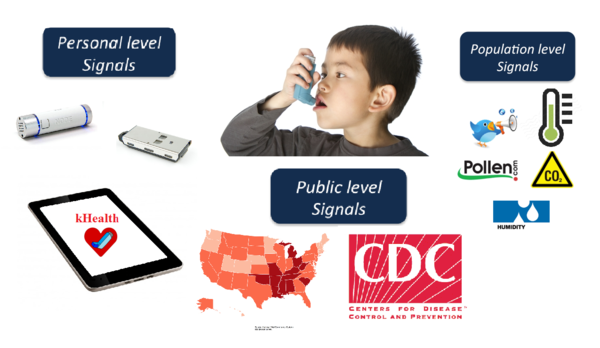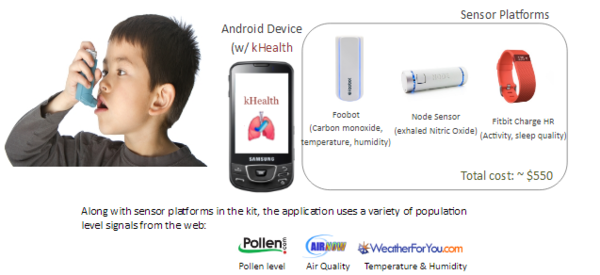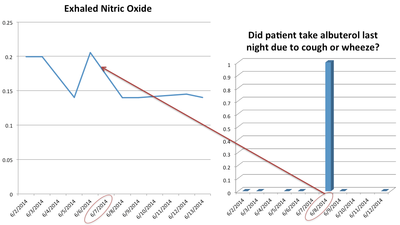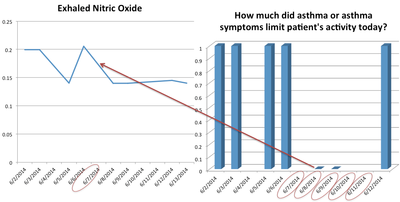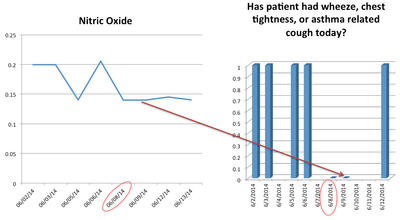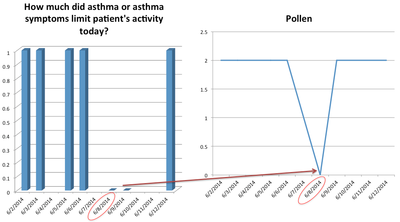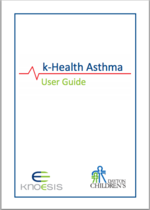Difference between revisions of "KHealth: Semantic Multisensory Mobile Approach to Personalized Asthma Care"
(→Asthma: Challenges and Opportunities) |
(→kHealth for Asthma) |
||
| Line 8: | Line 8: | ||
==kHealth for Asthma== | ==kHealth for Asthma== | ||
| − | We tackle this important problem by a combination of active and passive sensing. Active sensing involves the patient in the loop (obtrusive) while the passive sensing does not involve patient involvement (unobtrusive). Using a novel approach of | + | We tackle this important problem by a combination of active and passive sensing. Active sensing involves the patient in the loop (obtrusive) while the passive sensing does not involve patient involvement (unobtrusive). Using a novel approach of utilizes low-cost sensors for continuous monitoring (active and passive sensing), we propose to develop algorithms that can take this multi-modal data and translate them to practical and actionable information for asthma patients and their healthcare provider. Specifically, provide information on asthma control level based on symptoms and their severity, asthma triggers and early alerts for increasing asthma symptoms. |
[[File:khealth-asthma-kit.png | kHealth kit for Asthma |600px]] | [[File:khealth-asthma-kit.png | kHealth kit for Asthma |600px]] | ||
Revision as of 19:37, 2 December 2014
Contents
Motivation and Background
More than 25 million people in the U.S. are diagnosed with asthma, out of which 7 million are children [1]. Asthma related healthcare costs alone are around $50 billion a year [2]. Current reactive healthcare costs more than 17% of GDP in the US [3, 4]. Specifically, with the current reactive care for asthma, there were 155,000 hospital admissions and 593,000 ER visits in 2006 [16]. It is estimated that, by 2025, over 400 million people will be affected by asthma worldwide. With increasing adoption of mobile devices and low-cost sensors, an unprecedented amount of data is being collected by people [5]. This data collection has exacerbated the problem of understanding the data and making sense of it. In this project, we explore the role of knowledge empowered algorithms in making sense of this data deluge in the context of asthma assessment and management.
Asthma: Challenges and Opportunities
Asthma is a good example of a problem that spans Physical-Cyber-Social (PCS) systems. The health signals related to asthma spans Physical (environmental), Cyber (CDC reports), and Social (asthma/symptom reports on social media) modalities. Specifically, for asthma, we group health signals as personal (wheezing level, exhaled Nitric Oxide), population (asthma reports on social media), and public health signals (CDC asthma reports).
kHealth for Asthma
We tackle this important problem by a combination of active and passive sensing. Active sensing involves the patient in the loop (obtrusive) while the passive sensing does not involve patient involvement (unobtrusive). Using a novel approach of utilizes low-cost sensors for continuous monitoring (active and passive sensing), we propose to develop algorithms that can take this multi-modal data and translate them to practical and actionable information for asthma patients and their healthcare provider. Specifically, provide information on asthma control level based on symptoms and their severity, asthma triggers and early alerts for increasing asthma symptoms.
kHealth Observations
Asthma is a multi-faceted problem and we propose a holistic solution for
Personal
Physiological: Wheezometer [6], Nitric Oxide [7], Accelerometer, Microphone, Contextual Questions
Environmental: Sensordrone [8], Dust Sensor [9], Location
Public Health
CDC [10], DCHC’s EMR Records (periodic manual review)
Population Level
Everyaware [11], AirQuality Egg [12], Allergy Alerts [13,14], Social Observations (e.g., tweets), Air Quality Index[15]
Preliminary Data Analysis
kHealth kit could be used to collect observations (both sensor and patient’s answers to the questionnaire) in the patient home environment (which was never accessible in a quantitative form to doctors). These observations when collected based on expert guidance, prove valuable for clinical decision support. These observations when interpreted by a doctor, lead some interesting insights:
- Medication (Albuterol) related to decreasing exhaled Nitric Oxide
- Activity limitation related to high exhaled Nitric Oxide
- Low exhaled Nitric Oxide observed with absence of coughing
- Activity limitation observed with high pollen activity
Copy of IRB
Dayton Children's has approved the IRB in October 2013 for a study involving patients using the kHealth kit for Asthma. Please contact Prof. Amit Sheth [amit at knoesis.org] or Dr. Shalini Forbis [ForbisS at childrensdayton.org] to obtain the exact copy of IRB.
kHealth User Manual
kHealth Video Introduction
kHealth Vision
Digital health and mobile health applications are benefitting from semantic web research from Wright State's Ohio Center of Excellence in Knowledge-Enabled Computing (Kno.e.sis). Director of Kno.e.sis and Professor of Computer Science and Engineering Dr. Amit Sheth describes development of mobile health applications with sensor technology to monitor patient health, mobile computational support, and clear feedback to the patient and physician.
References
[1] NHLBI description of Asthma, Available online at: http://www.nhlbi.nih.gov/health/health-topics/topics/asthma/
[2] Asthma related facts, Available online at: http://www.lung.org/lung-disease/asthma/resources/facts-and-figures/asthma-in-adults.html
[3] Squires, D. A., The U.S. Health System in Perspective: A Comparison of Twelve Industrialized Nations, June 2011, Available online at: http://bit.ly/oZwhFZ
[4] Health Costs: How the U.S. Compares With Other Countries, Available online at: http://www.pbs.org/newshour/rundown/2012/10/health-costs-how-the-us-compares-with-other-countries.html
[5] Quantified Self http://quantifiedself.com/
[6] Wheezometer by iSonea, Available online at: http://www.isoneamed.com/wheezometer.html
[7] Nitric Oxide Sensor, Available online at: http://nodesensors.com/product/oxa-gas-sensor-nitric-oxide-no/
[8] Sensordrone, a bluetooth enabled low-cost sensor for monitoring the environment, Available online at: http://www.kickstarter.com/projects/453951341/sensordrone-the-6th-sense-of-your-smartphoneand-be/
[9] Optical Dust Sensor, Available online at: https://www.sparkfun.com/products/9689
[10] Centers for Disease Control and Prevention, Available online at: http://www.cdc.gov/
[11] Everyaware, Sensing Air Pollution, Available online at: http://www.everyaware.eu/activities/case-studies/air-quality/
[12] Community-led sensing of AirQuality, Available online at: http://airqualityegg.com/
[13] National and Local Allergy Forecast, Available online at: http://www.pollen.com/allergy-weather-forecast.asp
[14] National Allergy Bureau Alerts, Available online at: http://www.aaaai.org/global/nab-pollen-counts.aspx
[15] Air Quality Index from United States Environmental Protection Agency, Available online at : http://www.epa.gov/
[16] Akinbami et al. (2009). Status of childhood asthma in the United States, 1980–2007. Pediatrics,123(Supplement 3), S131-S145.
